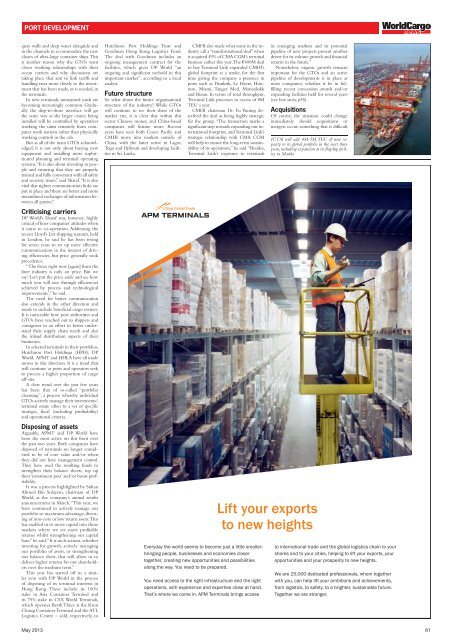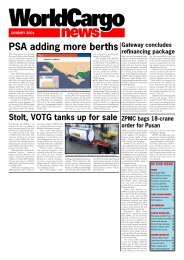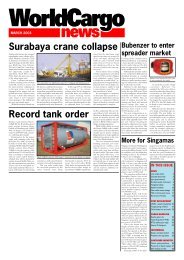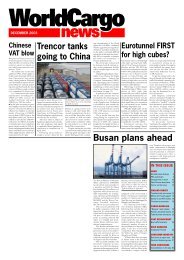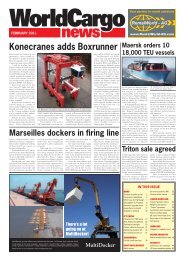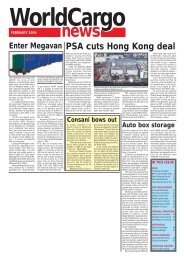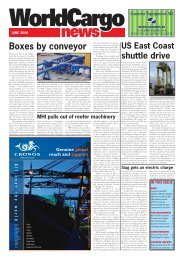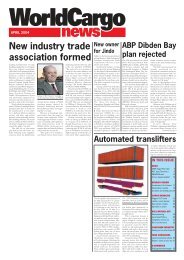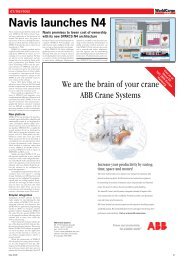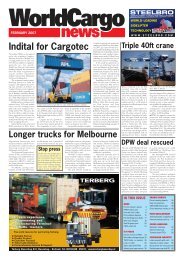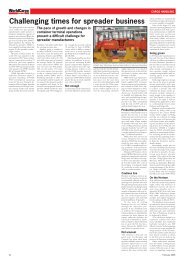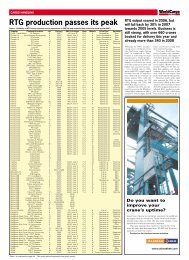Tanjung Priok super port - WorldCargo News Online
Tanjung Priok super port - WorldCargo News Online
Tanjung Priok super port - WorldCargo News Online
Create successful ePaper yourself
Turn your PDF publications into a flip-book with our unique Google optimized e-Paper software.
PORT DEVELOPMENT<br />
quay walls and deep water alongside and<br />
in the channels to accommodate the new<br />
classes of ultra-large container ships. This<br />
is another reason why the GTOs want<br />
closer working relationships with their<br />
ocean carriers and why discussions are<br />
taking place that aim to link tariffs and<br />
handling rates more closely to the investment<br />
that has been made, or is needed, in<br />
the terminals.<br />
In new terminals, unmanned yards are<br />
becoming increasingly common. Gradually<br />
the ship-to-shore interface will go<br />
the same way as the larger cranes being<br />
installed will be controlled by operatives<br />
working the units remotely from computer<br />
work stations rather than physically<br />
working controls in the cab.<br />
But as all of the main GTOs acknowledged,<br />
it is not only about buying new<br />
equipment and installing more sophisticated<br />
planning and terminal operating<br />
systems. “It is also about investing in people<br />
and ensuring that they are properly<br />
trained and fully conversant with all safety<br />
and security issues,” said Sharaf. “It is also<br />
vital that tighter communication links are<br />
put in place and there are better and more<br />
streamlined exchanges of information between<br />
all parties.”<br />
Criticising carriers<br />
DP World’s Sharaf was, however, highly<br />
critical of liner companies’ attitudes when<br />
it came to co-operation. Addressing the<br />
recent Lloyd’s List shipping summit, held<br />
in London, he said he has been trying<br />
for seven years to set up more effective<br />
communications in the interest of driving<br />
efficiencies, but price generally took<br />
precedence.<br />
“The focus right now [again] from the<br />
liner industry is only on price. But we<br />
say: ‘Let’s put the price aside and see how<br />
much you will save through efficiencies<br />
achieved by process and technological<br />
improvements’,” he said.<br />
The need for better communication<br />
also extends in the other direction and<br />
needs to include beneficial cargo owners.<br />
It is noticeable how <strong>port</strong> authorities and<br />
GTOs have reached out to shippers and<br />
consignees in an effort to better understand<br />
their supply chain needs and also<br />
the inland distribution aspects of their<br />
businesses.<br />
In selected terminals in their <strong>port</strong>folios,<br />
Hutchison Port Holdings (HPH), DP<br />
World, APMT and HHLA have all made<br />
moves in this direction. It is a trend that<br />
will continue as <strong>port</strong>s and operators seek<br />
to process a higher pro<strong>port</strong>ion of cargo<br />
off-site.<br />
A clear trend over the past few years<br />
has been that of so-called “<strong>port</strong>folio<br />
cleansing”, a process whereby individual<br />
GTOs actively manage their investments/<br />
terminal estate often to a set of specific<br />
strategic, fiscal (including profitability)<br />
and operational criteria.<br />
Disposing of assets<br />
Arguably, APMT and DP World have<br />
been the most active on this front over<br />
the past two years. Both companies have<br />
disposed of terminals no longer considered<br />
to be of core value and/or when<br />
they did not have management control.<br />
They have used the resulting funds to<br />
strengthen their balance sheets, top up<br />
their ‘investment pots’ and/or boost profitability.<br />
It was a process highlighted by Sultan<br />
Ahmed Bin Sulayem, chairman of DP<br />
World, at the company’s annual results<br />
announcement in March. “This year, we<br />
have continued to actively manage our<br />
<strong>port</strong>folio to maximum advantage, divesting<br />
of non-core or low return assets. This<br />
has enabled us to move capital into those<br />
markets where we see more profitable<br />
returns whilst strengthening our capital<br />
base,” he said. “It is such actions, whether<br />
investing for growth, actively managing<br />
our <strong>port</strong>folio of assets, or strengthening<br />
our balance sheet, that will allow us to<br />
deliver higher returns for our shareholders<br />
over the medium term.”<br />
This year has started off in a similar<br />
vein with DP World in the process<br />
of disposing of its terminal interests in<br />
Hong Kong. These include its 100%<br />
stake in Asia Container Terminal and<br />
its 75% stake in CSX World Terminals,<br />
which operates Berth Three at the Kwai<br />
Chung Container Terminal and the ATL<br />
Logistics Centre – sold, respectively, to<br />
Hutchison Port Holdings Trust and<br />
Goodman Hong Kong Logistics Fund.<br />
The deal with Goodman includes an<br />
ongoing management contract for the<br />
facilities, which gives DP World “an<br />
ongoing and significant toehold in this<br />
im<strong>port</strong>ant market”, according to a local<br />
analyst.<br />
Future structure<br />
So what about the future organisational<br />
structure of the industry While GTOs<br />
will continue to see their share of the<br />
market rise, it is clear that within this<br />
sector Chinese money and China-based<br />
companies will feature more. Recent<br />
years have seen both Cosco Pacific and<br />
CMHI move into markets outside of<br />
China, with the latter active in Lagos,<br />
Togo and Djibouti and developing facilities<br />
in Sri Lanka.<br />
CMHI also made what some in the industry<br />
call a “transformational deal” when<br />
it acquired 49% of CMA CGM’s terminal<br />
business earlier this year. The €400M deal<br />
to buy Terminal Link expanded CMHI’s<br />
global footprint at a stroke, for the first<br />
time giving the company a presence in<br />
<strong>port</strong>s such as Dunkirk, Le Havre, Houston,<br />
Miami, Tanger Med, Marsaxlokk<br />
and Busan. In terms of total throughput,<br />
Terminal Link processes in excess of 8M<br />
TEU a year.<br />
CMHI chairman Dr. Fu Yuning described<br />
the deal as being highly strategic<br />
for the group. “The transaction marks a<br />
significant step towards expanding our international<br />
footprint, and Terminal Link’s<br />
strategic relationship with CMA CGM<br />
will help to ensure the long-term sustainability<br />
of its operations,” he said. “Besides,<br />
Terminal Link’s exposure to terminals<br />
Everyday the world seems to become just a little smaller;<br />
bringing people, businesses and economies closer<br />
together, creating new op<strong>port</strong>unities and possibilities<br />
along the way. You need to be prepared.<br />
You need access to the right infrastructure and the right<br />
operations, with experience and expertise close at hand.<br />
That’s where we come in. APM Terminals brings access<br />
in emerging markets and its potential<br />
pipeline of new projects present another<br />
driver for its volume growth and financial<br />
returns in the future.”<br />
Nonetheless, organic growth remains<br />
im<strong>port</strong>ant for the GTOs and an active<br />
pipeline of developments is in place at<br />
most companies, whether it be in fulfilling<br />
recent concession awards and/or<br />
expanding facilities held for several years<br />
(see box story, p55).<br />
Acquisitions<br />
Of course, the situation could change<br />
immediately should acquisitions or<br />
mergers occur, something that is difficult<br />
ICTSI will add 4M-5M TEU of new capacity<br />
to its global <strong>port</strong>folio in the next three<br />
years, including expansion at its flagship facility<br />
in Manila<br />
Lift your ex<strong>port</strong>s<br />
to new heights<br />
to international trade and the global logistics chain to your<br />
shores and to your cities, helping to lift your ex<strong>port</strong>s, your<br />
op<strong>port</strong>unities and your prosperity to new heights.<br />
We are 25,000 dedicated professionals, whom together<br />
with you, can help lift your ambitions and achievements,<br />
from logistics, to safety, to a brighter, sustainable future.<br />
Together we are stronger.<br />
May 2013 61


